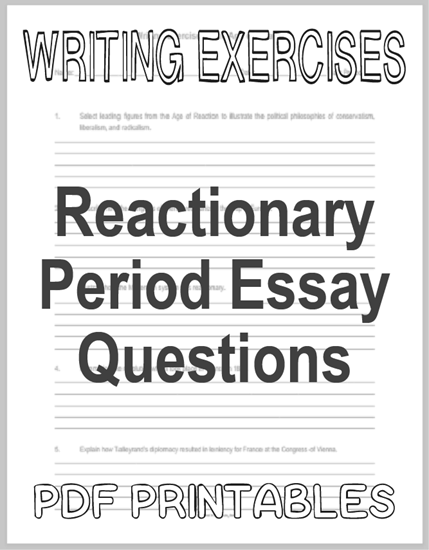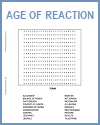| Reactionary Period Essay Questions |
|---|
| www.studenthandouts.com ↣ World History ↣ Age of Reaction ↣ Age of Reaction Worksheets |
 |  |
|---|
|
Writing Exercises - The Age of Reaction, Handout #1: Answer each of the following questions using complete sentences. 1. Describe the actions taken by the Congress of Vienna to establish a balance of power in Europe. The Congress of Vienna (1814-1815) aimed to restore stability and prevent future wars by establishing a balance of power in Europe after the Napoleonic Wars. It redrew national boundaries, restored monarchies, and strengthened countries around France to contain its influence. Key actions included enlarging Prussia and Austria, uniting the Netherlands and Belgium, and forming alliances to maintain peace. 2. Explain the differences between radicals, liberals, conservatives, and reactionaries. Radicals sought complete political or social change, often supporting revolution and equality. Liberals favored reform, constitutional government, and individual rights, aiming to expand freedoms without overthrowing systems. Conservatives wanted to preserve traditional institutions, monarchies, and social hierarchies. Reactionaries went further, seeking to reverse recent changes and restore past orders. Each group reflected differing views on authority, progress, and social structure. 3. Describe the causes and results of the Revolutions of 1830 and 1848. The Revolutions of 1830 and 1848 were sparked by demands for political reform, national independence, and social justice. Economic hardship, rising nationalism, and dissatisfaction with monarchies fueled unrest across Europe. In 1830, France replaced its king, and Belgium gained independence. The 1848 revolutions were more widespread but largely unsuccessful, as conservative forces regained control. Still, they planted seeds for future democratic and national movements. Click here to print. Answers will vary. |
|
Writing Exercises - The Age of Reaction, Handout #2: 1. Select leading figures from the Age of Reaction to illustrate the political philosophies of conservatism, liberalism, and radicalism. Prince Klemens von Metternich of Austria represented conservatism, advocating monarchy, tradition, and suppression of revolutionary movements. Liberalism was championed by figures like John Stuart Mill, who promoted individual rights, free speech, and representative government. Radicalism was exemplified by Karl Marx, who called for revolutionary change to overthrow capitalism and create a classless society. Each embodied distinct visions for post-Napoleonic Europe. 2. Describe how the Congress of Vienna reorganized the map of Europe. The Congress of Vienna reorganized Europe to restore balance and prevent future French aggression. France's borders were reduced to pre-Napoleonic lines, and strong neighboring states were created or strengthened. The Austrian Empire gained territory in Italy and Central Europe, Prussia expanded westward, and the Netherlands and Belgium were united. These changes aimed to maintain peace through a stable power structure. 3. Illustrate how the Metternich system was reactionary. The Metternich system was reactionary because it aimed to suppress liberal and nationalist movements and restore pre-revolutionary monarchies. Metternich promoted censorship, secret police, and alliances like the Holy Alliance to crush uprisings and maintain aristocratic control. His policies opposed constitutional reforms and democratic ideals, seeking to preserve traditional power structures and resist the changes sparked by the French Revolution. 4. Summarize the revolution which took place in France in 1830. The French Revolution of 1830, known as the July Revolution, was sparked by King Charles X's attempt to limit civil liberties and restore absolute monarchy. In response, workers and middle-class citizens revolted in Paris. After three days of fighting, Charles X abdicated and fled. Louis-Philippe, the "Citizen King," took the throne, marking a shift to a constitutional monarchy. 5. Explain how Talleyrand's diplomacy resulted in leniency for France at the Congress of Vienna. Talleyrand's skilled diplomacy at the Congress of Vienna helped France avoid harsh punishment after Napoleon's defeat. He positioned France as a key player in restoring European stability and exploited divisions among the other powers. By aligning France with balance-of-power principles, Talleyrand secured more favorable terms, preserving France's status and avoiding significant territorial losses or crippling reparations. Click here to print. Answers will vary. |
| Age of Reaction Books and Films | Age of Reaction Outlines and PowerPoints |
| Age of Reaction Maps and Pictures | Age of Reaction Study Games |
| Age of Reaction Miscellany | Age of Reaction Worksheets |
| www.studenthandouts.com ↣ World History ↣ Age of Reaction ↣ Age of Reaction Worksheets |










